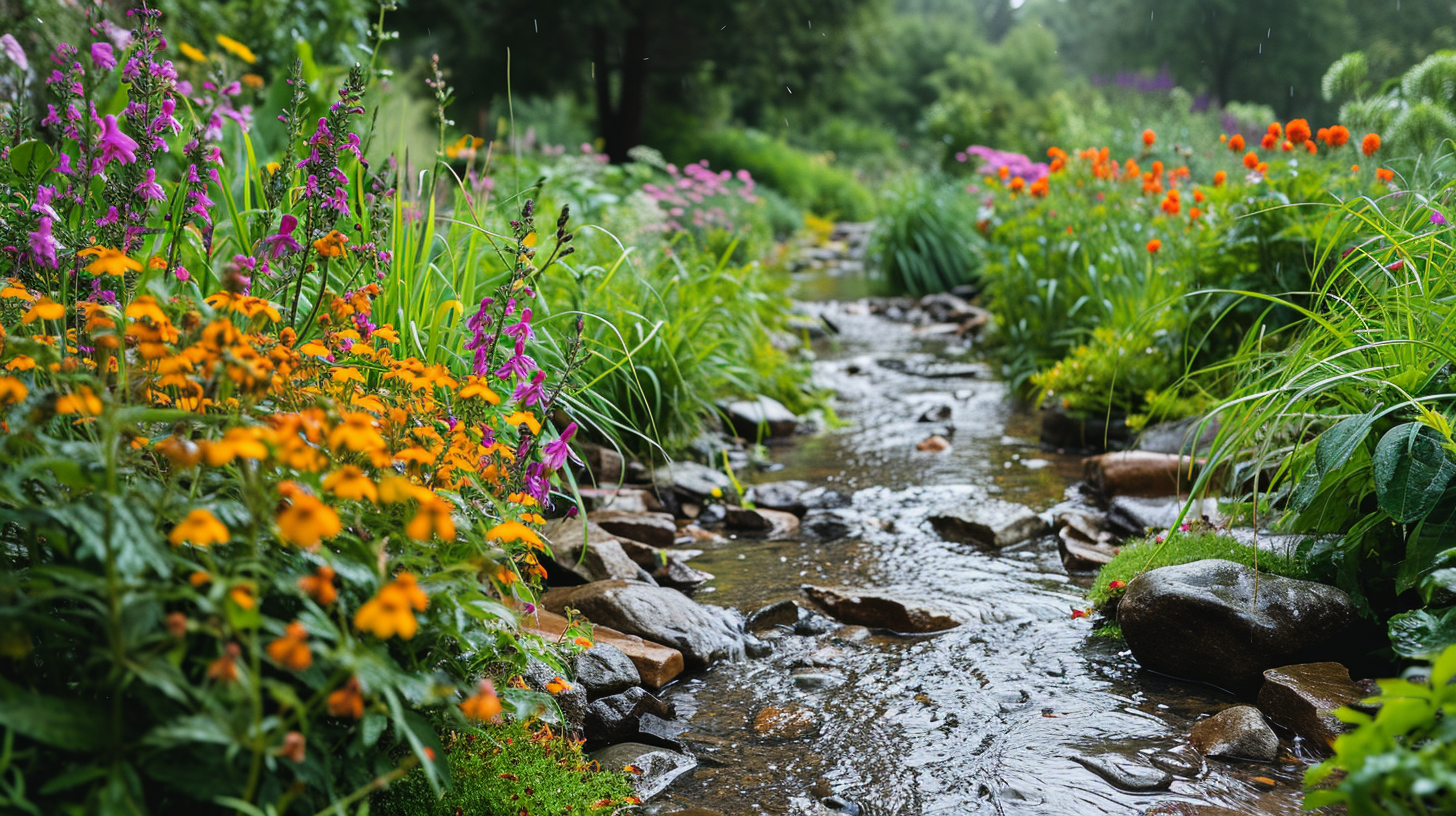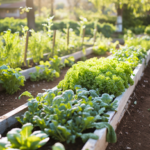Are you interested in creating a sustainable and eco-friendly landscape? Look no further than installing a rain garden. This article will guide you through the step-by-step process of creating your own rain garden oasis. From selecting the ideal location to preparing the site and choosing native plants, we will provide you with the knowledge and tools needed to successfully install and maintain a rain garden that not only beautifies your property but also helps manage stormwater runoff.
Determine the Ideal Location for Your Rain Garden
To ensure optimal water drainage, it is crucial to carefully assess and evaluate various factors in order to determine the ideal location for your rain garden. When selecting the ideal location for your rain garden, there are several key considerations to keep in mind. Firstly, it is important to choose an area that receives ample sunlight, as this will promote healthy plant growth and enhance the garden’s ability to absorb and filter rainwater. Additionally, the ideal location should be away from any structures or utility lines to prevent potential damage. Furthermore, selecting a spot that is slightly lower than the surrounding area will aid in water collection and prevent runoff. By choosing the ideal location for your rain garden, you can maximize its benefits, such as reducing stormwater runoff, improving water quality, and providing habitat for native plants and wildlife.
Assess the Soil and Drainage Conditions
In order to accurately evaluate the soil and drainage conditions of the potential rain garden site, it is essential to thoroughly analyze and consider the available data and conduct necessary tests. Soil testing is a crucial step in determining the suitability of the soil for a rain garden. This involves collecting soil samples from different areas of the site and testing them for various parameters such as pH, texture, and nutrient content. The results of the soil testing will provide valuable insights into the soil’s ability to absorb and retain water, which is essential for the success of a rain garden. Additionally, a drainage assessment should be conducted to determine the site’s natural drainage patterns. This involves observing the flow of water during rainfall events and identifying any potential drainage issues that may need to be addressed before constructing the rain garden. By thoroughly analyzing the soil and conducting a drainage assessment, one can ensure that the rain garden is installed in the most suitable location, maximizing its effectiveness in managing stormwater runoff.
Choose the Right Native Plants for Your Rain Garden
When selecting native plants for your rain garden, it is important to consider their ability to thrive in the specific soil and climate conditions of your area. Native plant selection is crucial for the long-term success and sustainability of your rain garden. Native plants are adapted to the local environment, making them more resilient and less dependent on excessive watering or chemical treatments. These plants have deep root systems that help improve soil health, prevent erosion, and filter out pollutants. Additionally, native plants attract and support local wildlife, creating a balanced ecosystem. To ensure proper rain garden maintenance, choose a variety of native plants that bloom at different times throughout the year, providing continuous food and habitat for pollinators and other beneficial insects. Regular weeding, mulching, and occasional pruning will help maintain the health and beauty of your rain garden.
Calculate the Size and Shape of Your Rain Garden
When planning your rain garden, it is important to calculate the size and shape that will best suit your needs. Proper dimensions are crucial for optimal drainage and to ensure that the garden can capture and filter runoff effectively. Additionally, designing the ideal shape will not only enhance the aesthetics of your rain garden but also help in directing the flow of water for proper distribution.
Proper Rain Garden Dimensions
To ensure the effectiveness of your rain garden, it is essential to carefully calculate the dimensions and shape of the garden. Proper rain garden dimensions play a crucial role in maximizing its benefits and ensuring its proper functioning. When determining the size of your rain garden, consider factors such as the size of the contributing impervious area, the soil type, and the local climate. The shape of the rain garden should be designed to allow for efficient water flow and infiltration. A well-designed rain garden can help reduce stormwater runoff, prevent soil erosion, and improve water quality by filtering pollutants. Regular maintenance of the rain garden, including removing debris, weeding, and checking for proper water flow, is also important to ensure its long-term effectiveness. Taking the time to calculate and plan the dimensions of your rain garden will help optimize its performance and maximize its benefits.
Designing the Ideal Shape
In order to achieve optimal functionality and water flow, careful consideration must be given to the size and shape of your rain garden. When designing the ideal shape for your rain garden, it is important to incorporate designing techniques that not only enhance its functionality but also its visual appeal. Aesthetic considerations play a significant role in creating a rain garden that seamlessly blends with its surroundings and adds beauty to your landscape.
One designing technique is to create a curvilinear shape for your rain garden. Curves not only add visual interest but also help to slow down the flow of water, allowing it to infiltrate the soil more effectively. Another technique is to incorporate different levels or terraces within the rain garden, which not only adds dimension but also helps to retain water and prevent erosion.
Furthermore, consider the aesthetic aspects such as the choice of plants, colors, and textures that will complement the overall design of your rain garden. By carefully considering both designing techniques and aesthetic considerations, you can create a rain garden that not only effectively manages stormwater but also enhances the beauty of your landscape.
Size for Optimal Drainage
Achieving optimal drainage in a rain garden requires careful consideration of the size and shape, as well as the incorporation of effective designing techniques. When it comes to the size of the garden, it is crucial to strike a balance between capturing an adequate amount of rainwater and preventing overflow. A garden that is too small may not be able to handle heavy rainfall, leading to flooding and water pooling. On the other hand, a garden that is too large may not effectively utilize the rainwater, leading to stagnant water and potential mosquito breeding grounds. Determining the optimal rainwater garden size depends on factors such as the average annual rainfall in the area, the size of the catchment area, and the permeability of the soil. It is important to consult with experts or follow guidelines to ensure the size is appropriate for efficient drainage and water management.
Prepare the Site for Rain Garden Installation
Before installing a rain garden, it is crucial to prepare the site properly. This involves conducting soil testing and making necessary soil amendments to create an optimal environment for plant growth. Additionally, choosing native plants is essential to ensure their adaptability to the local climate and promote biodiversity. Finally, implementing proper drainage techniques is crucial to prevent waterlogging and ensure the successful functioning of the rain garden.
Soil Testing and Preparation
Once the appropriate soil testing and preparation is completed, the site will be ready for the installation of the rain garden. Soil testing is a crucial step in determining the composition and health of the soil, as well as its suitability for supporting a rain garden. By analyzing the soil’s pH levels, nutrient content, and drainage capabilities, gardeners can make informed decisions about the types of plants that will thrive in the garden. Additionally, soil preparation involves improving the soil’s structure and fertility through techniques such as adding organic matter and adjusting pH levels if necessary. This ensures that the plants will have a healthy environment to grow and flourish. By conducting soil testing and implementing effective planting techniques, the rain garden can be established successfully, providing numerous benefits such as reducing stormwater runoff and providing habitat for wildlife.
Choosing Native Plants
When selecting native plants for a rain garden, it is important to consider their adaptability and resilience, as well as their ability to attract local pollinators and support biodiversity. Native plants offer numerous benefits for rain gardens. They have evolved to thrive in local climates and soil conditions, making them more adaptable to changing weather patterns and requiring less maintenance. By selecting the right native plants, you can create a sustainable and low-maintenance rain garden that not only helps manage stormwater runoff but also provides habitat for local wildlife. Native plants also have a higher chance of survival and success in a rain garden compared to non-native species. Additionally, native plants play a crucial role in supporting biodiversity by providing food and shelter for native insects, birds, and other wildlife. By prioritizing native plant species in rain garden design, you can maximize the ecological benefits and ensure a thriving, diverse ecosystem.
Proper Drainage Techniques
To ensure effective water management in a rain garden, implementing proper grading techniques is essential for achieving optimal drainage. Proper grading involves creating a slope in the rain garden design that allows water to flow away from the garden and towards a designated outlet. This helps prevent water from pooling and ensures that excess water is efficiently drained. The benefits of proper drainage in a rain garden are numerous. It helps to reduce the risk of waterlogging and soil erosion, promotes healthy plant growth, and prevents the accumulation of stagnant water that can attract mosquitoes and other pests. Additionally, proper drainage helps to filter and cleanse the water as it moves through the rain garden, improving overall water quality and reducing the burden on stormwater infrastructure. By implementing proper grading techniques, rain gardens can effectively manage water and provide numerous environmental benefits.
Dig the Basin and Shape the Slopes
Why do we need to carefully dig the basin and shape the slopes when installing a rain garden? Basin excavation and slope shaping are crucial steps in the installation process of a rain garden. The purpose of digging the basin is to create a bowl-shaped depression that collects and retains rainwater. This allows the water to slowly infiltrate into the ground, reducing stormwater runoff and preventing erosion. By carefully shaping the slopes of the basin, we can ensure that the water flows into the garden evenly and efficiently. Proper slope shaping helps to prevent pooling and stagnant water, which can lead to the growth of mosquitoes and other pests. Additionally, well-shaped slopes promote healthy plant growth and enhance the overall aesthetics of the rain garden. Therefore, attention to detail during basin excavation and slope shaping is essential for the successful installation of a rain garden.
Install the Underlayment and Mulch
We should carefully spread a thick layer of underlayment and mulch over the rain garden to provide adequate insulation and moisture retention. When it comes to mulch application, it is important to choose the right type of material. Organic mulches, such as wood chips or shredded bark, are commonly used in rain gardens due to their ability to retain moisture and slowly release it into the soil. These materials also help to suppress weed growth and protect the plants from extreme temperature changes. As for underlayment materials, a geotextile fabric is often recommended. This fabric helps to prevent soil erosion and allows water to drain through while keeping the underlying soil in place. By applying underlayment and mulch, we can ensure that our rain garden remains healthy and effective in managing stormwater runoff.
Maintain and Monitor Your Rain Garden for Optimal Performance
Regular maintenance and monitoring of the rain garden is essential to achieve optimal performance and ensure its effectiveness in managing stormwater runoff. Rain garden maintenance involves several key activities that should be performed on a regular basis. These include removing debris and weeds, checking and cleaning the inlet and outlet structures, and inspecting the plants for signs of disease or damage. Additionally, rain garden performance evaluation is crucial to identify any potential issues and make necessary adjustments. This can be done by monitoring the water infiltration rate, measuring the depth of standing water during a storm event, and assessing the overall health and growth of the plants. By regularly maintaining and monitoring the rain garden, homeowners and communities can ensure that it continues to function properly and effectively mitigate stormwater runoff.




